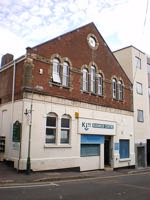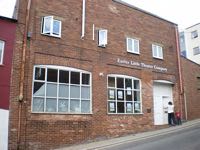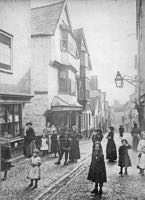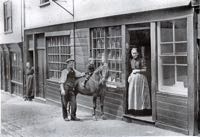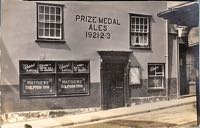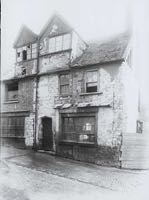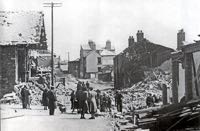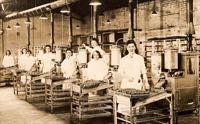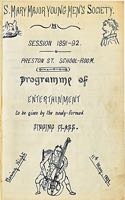
Preston Street
Page updated 4th April 2018
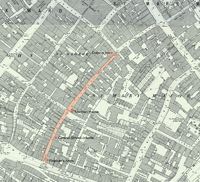 As they were no parish churches in Exeter,
there were no rectories, so the many priests lived in a street colony–a lease of 1296 mentions Prustene-Street or Vicus Presbyterorum or "the street of priests". The street also had two alternative names before the
19th Century when it was sometimes referred to as Back Lane or First Back Lane, and also Billiter Lane, although the latter referred to the northern end, beyond Market Street. Billiter Lane became know as Sun Street. Sun Street is one of the forgotten streets of the city, without a known photograph, before it was wiped out in the blitz.
As they were no parish churches in Exeter,
there were no rectories, so the many priests lived in a street colony–a lease of 1296 mentions Prustene-Street or Vicus Presbyterorum or "the street of priests". The street also had two alternative names before the
19th Century when it was sometimes referred to as Back Lane or First Back Lane, and also Billiter Lane, although the latter referred to the northern end, beyond Market Street. Billiter Lane became know as Sun Street. Sun Street is one of the forgotten streets of the city, without a known photograph, before it was wiped out in the blitz.
Simon Grendon, Mayor in 1395, 1398, 1405 and 1406, founded Grendon's Almshouses, known as the Ten Cells in Preston Street. His gift was augmented by John Haydon, who also built a three arched bridge at Ottery St Mary. Izacke wrote:
"By his (John Haydon's) deed indented dated 6 Martii, 32 Elizabeth, Anno Domini, 1590, he (inter alia) gave the poor of the aforesaid Almshouse, the yearly sum of Forty-six Shillings and eight pence, to be bestowed in bread for them, at two feasts of the year at Christmas and Easter for ever."
The almshouses became dilapidated and were rebuilt in 1878.
Two important hostelries
The Mermaid Inn, accessed from Preston Street, was stated to be almost the equal to Exeter's premier New Inn, in the High Street. It was a large, sprawling, rambling building, with extensive cellars–the cellars survived into the last century, and were used as a wine and spirit store and an air raid shelter in the Second War. The building had a large oak staircase with a carved handrail and an assembly room, measuring 56ft by 17ft. It had an arched and moulded ceiling, "enriched with gold and colour", and a stone chimneypiece dated 1632, emblazoned with the arms of the Shapleigh and Slanning families. By 1880 it had all been demolished. T.J. Toce described the inn as "the house of Tudor days and personalities, down to recent times, and a noble and old building. The destruction and wrecking of its goodly timbers was a grievous loss to Exeter".
In 1764, from the Mermaid Inn, a company called Iliffe's Flying Van, owned by Edward Iliffe, in partnership with Thomas Parker of the New Inn, ran a passenger carriage known as a 'machine', every Monday to London, taking two days for the journey. Iliffe also ran fly wagons which carried goods every Monday, Tuesday and Thursday, in four and a half days. Iliffe sold the "Mermaid," about the year 1810, to Thomas Bury, a wool-stapler, who built a house in the yard.
The Dolphin Inn was located on the corner of Preston and Market Street. It too had a long history, and was an important destination for pack horses.
Frank Shooter, known as the Hero of the Exe was the landlord of the Fireman's Arms, on the corner of Preston and West Street, in 1892.
The Norman House
Exeter has long been careless with its historic heritage, and many a fine building, that would be coveted today, has been lost through council vandalism and war. The Norman House, on the corner of Preston and King Street, was first noticed during the first slum clearance of the West Quarter, at the beginning of the First War. The council stepped in, and restored it. It is said to have both Norman and 15th Century features–there remained the head of a Norman doorway and other fragments of Norman features, although they may not have been original to the building. Unfortunately, it was badly damaged during the blitz, and demolished after the war.
Poverty and deprivation
Preston Street was right at the heart of the Westquarter and as a consequence suffered much poverty and deprivation during the 19th-Century. Nothing demonstrates this better than the statistic for deaths from the cholera in 1832, where Preston Street suffered the highest mortality rate in the city with 47 deaths
The short lived Penny Bank for the poor in Preston Street, commenced trading in August 1861, to a warm welcome from the Trewman's Exeter Flying Post. It opened for business every Saturday night, between 7 and 8.30pm, in a room in the street. There was very quickly, 236 depositors of a total sum of £3 11 shillings. The hon. treasurer was a Mr William Townsend. Eight years later and it was noted that 10 boys from the West Street Ragged School had savings in the bank. The movement also had a bank at the St James' Parochial Institute, St SIdwell and in St Thomas.
The Working Men's Improvement Society had rooms in Preston Street where concerts and talks were given. They were given a lecture by the Rev. M Swabey on "Glimpses of Canadian Life", in 1875, perhaps encouraging a few to consider emigration. The newspapers were full of small adverts for steamship companies, offering passage to the USA, Australia and Canada at this time.
A rough area
Although using abusive language was a very common offence, one case in Preston Street in June 1893 seems to have stirred up the neighbours. Martha Davey was summoned for abusing her husband at four in the morning. Her husband complained to a constable, and a neighbour stated that the noise had continued from 10.30 on Saturday night to four the next morning. Another neighbour said "the defendant's "oration" lasted so long that he could hardly say what she had said". The neighbours could get no rest and Davey "upset the furniture, and "turned her son, daughter, and husband to doors"." Some of her neighbours were considering a petition to "have her heaved out of the street, for her conduct was not fitting for such a respectable place as Preston Street (Laughter)." The defendant said she "was having a few words with her husband"." She was fined 10s, but could not pay and spent seven days in prison. No ASBOS then!
Preston Street's public houses, especially in the 19th-Century were often in the local newspapers. One such, the Brewer's Arms, also known as the Labour in Vain, had a short and infamous life. Joshua Lawton, the landlord was summoned, in 1847, by his neighbour, Mr Fildew a bookseller, for noise, abusive behaviour, drunkenness and hosting prostitution. Lawton was fined 20s and 17s 6d expenses. In October 1849, Lawton was mentioned in a case as the keeper of the Brewer's Arms who had been imprisoned for keeping a disorderly house. His wife was prosecuted for attempting to smuggle tobacco to him while in prison, for which she was sent to prison herself, for fourteen days.
Their bad behaviour continued in November 1849, when a case was again reported by the Flying Post with the weary headline "The Labour in Vain Beer House Once More." The report went on "This beer house has become celebrated in police annals." Lawton was prosecuted for allowing fighting and prostitution. He was found guilty, fined £10 and he forfeited his licence. One known derivation of the name Labour in Vain was often displayed on the sign showing a black-boy being washed to make him white - they weren't so politically correct in former times.
The Forte family came to Exeter in the 1890's and founded an an ice cream factory in the street. They installed the very latest technology in the making of ice-cream using American Creamery Package machines as well as Giusti and Carpigiani along with pasteurisers and homogenisers.
A little later, in 1901, Wheaton's the printers expanded by purchasing S Lee and Company in the street.
World War One Dead - Preston Street
Stoker 1st Class, Thomas
Howard, H.M.S. "Seagull.", Royal Navy. 30 September 1918. Age 25.
Preston St
Private, Albert John Howe, Hampshire Regiment. 29 August
1918. Age 19. Patten's Court, Preston St
Private, Joseph Mayne,
Devonshire Regiment. 25 September 1915. Age 26. Preston St
In 1925, the Improvement Commission suggested that No 4 area, (West Quarter) be improved. Preston Street was widened to 30ft. In May 1931, Nos 26-40, 59-74 Preston Street, Prospect Place, and Rack Street were listed for demolition. Four new houses were to be built in the street with 74 further houses for the vacated inhabitants in Buddle Lane and Burnthouse Lane.
The modern street
Nowadays, the street is used as a shortcut by the buses - there is an automated traffic signal at the bottom that changes when a bus appears, allowing it priority. The Spacex Gallery, an independent display area for artists, a performance space and place for arts workshops is based in Preston Street; next to Spacex is the pottery of Ek Bowley and Eunice Calvert, working from a building that has features that suggest it was a dye house when the woollen industry was Exeter's power house. Both are worth a visit when wandering the West Quarter.
Exeter's Little Theatre Company, who are based in Friar's Gate, above the quay also have a workshop and store in the street, next to the pottery.
Also see the Newcombes of Preston Street
Sources: Local 19th Century newspapers, Robert Dymond's essay on Inns and Taverns of Exeter
Looking down Preston Street circa 1900.
Courts and
Places of Preston Street
David's Court
Prospect Place
Sander's
Court
Stone's Court
White Court
│ Top of Page │


